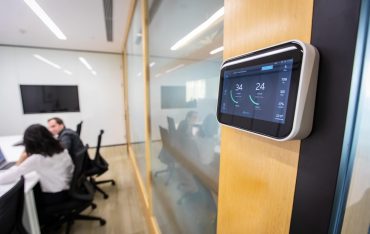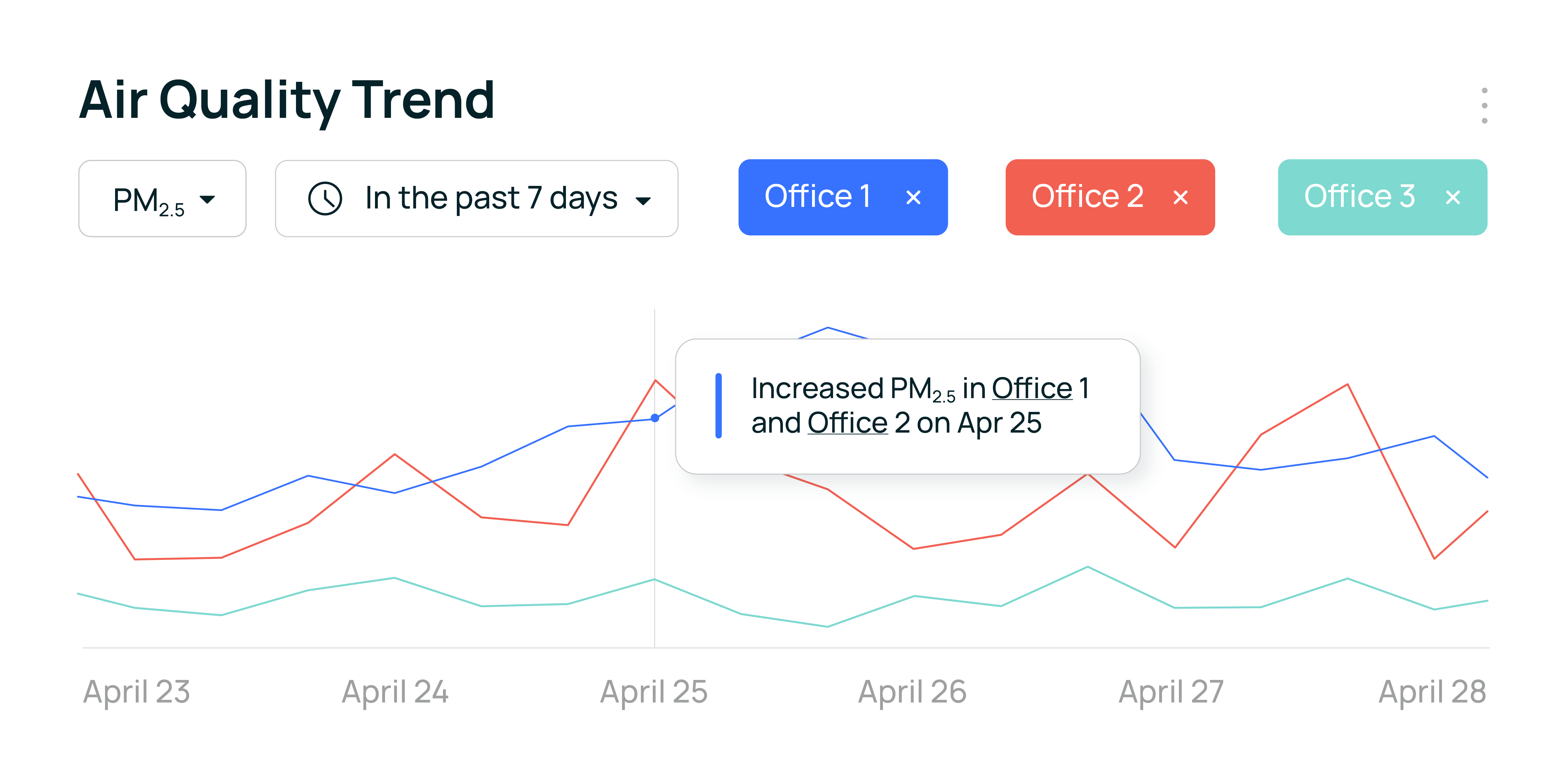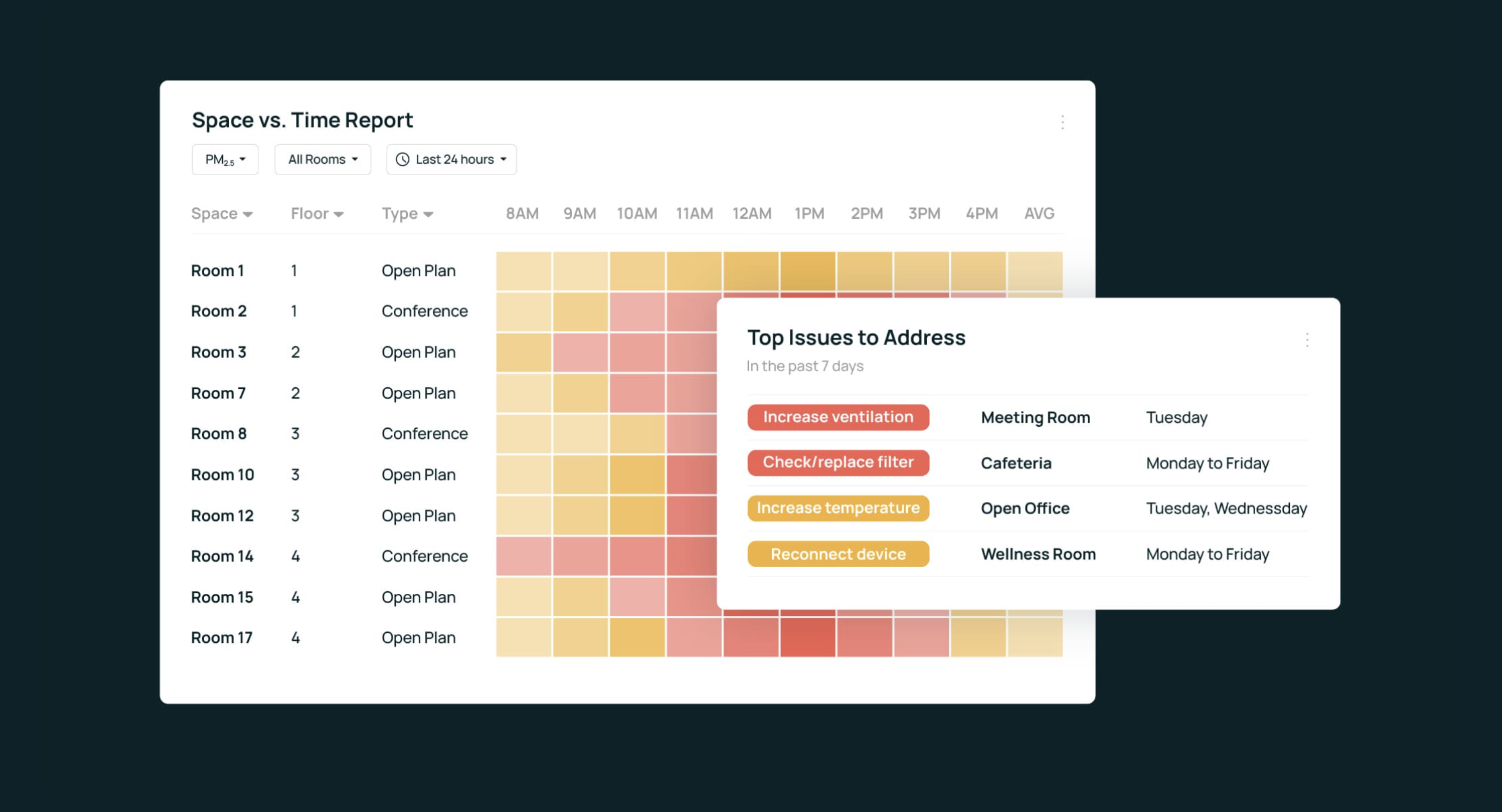Newsletter
Collecting indoor air quality (IAQ) data has been a focal point for businesses in recent years. But increasingly, it’s becoming clear that just having more data is not enough: businesses still struggle to understand, process, and operationalize the data they are collecting.
This article will look at the challenges and opportunities of utilizing IAQ data in healthy buildings. We’ll look at where the current gaps lie, and how the industry is changing to better address these issues and allow businesses to generate more value from the IAQ data they collect.
More Data Than Ever - But Not Enough Insights
A decade ago, most workplaces were flying blind when it came to indoor air quality. They lacked the most basic ingredient to data-driven decision-making – namely, the data. If testing was being conducted, it was done periodically or in response to worker complaints.
The pandemic has motivated a shift in attitudes: continuous IAQ monitoring is becoming mainstream, and it’s now fairly common to see IAQ monitors in office buildings. Sensor data is being collected, often in very large volumes, capturing the state of different air quality parameters over days, months, and years. (This is not to say adoption shouldn’t be higher - many businesses still aren’t collecting data.)

The problem is that all this raw data from IAQ monitors often leaves businesses perplexed when it comes to creating healthier buildings:
- Most stakeholders don’t have a strong understanding of the technicalities of air quality (nor should they). This creates difficulties in interpreting the numbers they are seeing in the monitoring data - does a TVOC level of 700 ppb mean there’s a problem? How urgent is this problem?
- On-site facility managers have basic reporting tools that can tell them averages and trends over time - e.g., of CO2 in a conference room. This is already much better than having no data at all, and can help to quickly identify acute issues. But it offers little in the way of remediation: Does this indicate an underlying ventilation issue, or just reflect occupancy trends? What actions can be taken to improve?
- Portfolio facility managers or workplace leaders who oversee many buildings and spaces struggle to get a bird’s-eye view of their entire portfolio: Which of my buildings is underperforming and requires my attention? Are there any common causes of poor air quality across my portfolio, such as material selection or space design? What best practices can I implement to prevent similar issues in the future?
These questions are often left unanswered, due to a threefold challenge in the way air quality data is collected and analyzed:
1. Lack of self-service analytics tools
While there are many IAQ monitoring solutions for collecting data, most offer only basic reporting based on predefined metrics. Further analysis is only possible by exporting the data and using 3rd party data integration, analysis, and visualization tools.
Due to the lack of accessible self-service analytics, many businesses have struggled to utilize their air quality data effectively. Static reports or default dashboards can tell you what’s happening right now, but don’t offer much in terms of further drill-down or root-cause investigation. Analyzing the data requires IT resources, and interpreting it to reach actionable conclusions requires domain expertise in air quality. This means that the process of turning data into insights can be slow, laborious, and expensive.
2. Insufficient standards and benchmarks
To interpret metrics such as TVOC or indoor ozone levels, businesses need a clear benchmark of what is acceptable and what needs to be improved. But indoor air quality standards have traditionally been limited, overly reliant on standards developed for ambient air, and failed to take into account the specific realities of the building. A school, a hospital, and an office building have different usage patterns and are frequented by different populations. Attempting to apply a one-size-fits-all approach doesn’t work.
This leads to confusion around interpreting air quality data and understanding whether a particular building’s performance is acceptable. Businesses struggle to understand the financial and health impact of measured parameters.
3. Siloed data
Smart building technologies can easily produce data silos. Sensors capture data around air quality, occupancy, noise levels, and more – but all this data is dispersed across multiple systems and formats, making it challenging to gain a comprehensive understanding of building performance without extensive manual effort.
For example, let’s say you look at your air quality data and see that CO2 levels are rising. This could be caused by an HVAC malfunction, higher occupancy rates, or recent changes made to ventilation levels. On the other hand, if CO2 levels are always low, this could indicate over-ventilation (and energy waste). When all these data points are available, businesses can be much quicker to identify what’s wrong – and fix it; whereas if each question requires a separate request to pull the dataset, and days or weeks until it’s ready, issues will not be addressed in a timely manner.
This leaves businesses with heaps of data that is rarely used in sophisticated ways. Data isn’t well-integrated into other systems or business processes; instead, it sits in databases or cloud storage and is rarely used by anyone.
The Next Frontier: Moving From Data-Informed to Data-Driven
Despite the challenges we described above. It’s important to note that the industry has made great strides in recent years. The availability of air quality data is a major step in the right direction, especially when compared to the previous situation, where building occupants were potentially exposed to poor air quality for prolonged periods of time.
In the next few years, however, we will see major advancements in making this data more actionable – turning business from merely data-informed to data-driven. This has already started to manifest in a new focus on software over hardware, more flexible air quality standards that are tailored to the specific needs of a building, and more integrated approaches to data utilization.
Let’s break down each of these trends to understand how they are reshaping the way businesses approach indoor air quality.
1. Software is the key to unlocking better insights
In the past, just collecting the data was a major challenge. Sensors were expensive to purchase and maintain, and only the most forward-thinking businesses were willing to make this investment. However, this is changing: IOT-enabled air quality sensors are becoming commoditized and thus more affordable; developments such as modular design are reducing total costs of ownership.
With data becoming much easier to collect, the main challenge - and the main differentiator between IAQ monitoring solutions - is software. When choosing a monitoring solution, the bare minimum is a product that allows you to effectively manage your data – granting you the ability to aggregate air quality data, create visualizations and reports, and enable self-service data mining and analytics.
The next generation of solutions will go one step further: not just making your data available for analysis, but analyzing it for you, producing insights and actionable suggestions. Recent advancements in AI and machine learning have the potential to automatically detect anomalies in air quality data, and find correlations with data from other smart building systems in order to isolate root causes and guide users toward possible solutions.
At Kaiterra, we’ve addressed this through our air quality dashboard. While other providers focus on static reports, we’ve provided a complete analytics platform that shows you a bird’s eye view of your data, but also allows you to drill further down into more granular reports, see historical trends, or set up real-time alerts. We’ve also automated the ability to generate reports for achieving building certification programs, allowing businesses to immediately generate value from their air quality data.

2. Better standards and guidance are coming
As the industry matures, air quality standards are evolving to meet the demands of modern organizations and reflect the latest understanding of indoor air quality. Both the public sector and private certification providers, such as WELL, LEED, and RESET, are driving this change.
There is a growing recognition that one-size-fits-all approaches, such as a fixed air exchange rate, are insufficient. Solutions for addressing IAQ must be flexible and performance-based, reflecting the unique characteristics of each building and space. This has led to the emergence of more precise and goal-oriented standards, such as the RESET Viral Index and the WELL Performance Rating.
Kaiterra is a member of the WELL Performance Rating Committee, contributing to the launch of this rating and driving the industry towards performance measurement through meaningful metrics, rather than just meeting minimum requirements.
3. From silos to a single pane of glass
Businesses understand the potential benefits of breaking down data silos – and better data connectivity for IAQ monitors is helping them achieve this goal.
This can manifest in automation, with IAQ data integrated into other aspects of building operations through automated systems (such as demand-controlled ventilation). IAQ systems and dashboards can also receive data from other parts of the building, such as occupancy monitoring sensors, to unlock more possibilities and facilitate better operational decisions.
It could also mean better access to data through centralized portals, allowing business leaders to incorporate air quality data into additional processes and decisions (such as around return to office, occupancy rates, or renovation schedules).
At Kaiterra, we aim to give businesses a single-pane-of-glass view of their facilities rather than keeping IAQ data isolated in separate tools or reports. This is why we’ve designed our systems with an API-first approach that allows developers to build applications that interact with the data the air quality sensors collect. Data can power additional business apps, web portals, or building management systems.
A Promising Future for IAQ Data
Air quality monitoring devices is evolving. Businesses are finally being provided with the tools to capture and analyze data about their buildings, and drive substantial value from it. In the long term, this will save time and money, reduce energy consumption, and improve the health of building occupants.
To learn more about the latest trends in IAQ data and how you can leverage them to make data-driven decisions, download our new whitepaper:






.png?width=200&height=148&name=Menu%20C%20(2).png)

.png?width=307&height=228&name=Menu%20-%20D%20(1).png)
.png)




